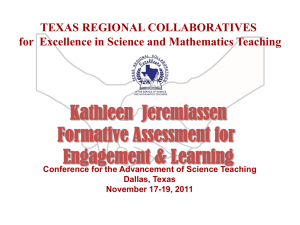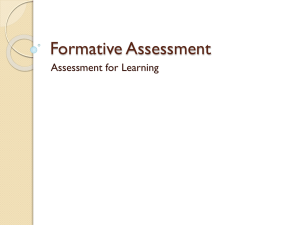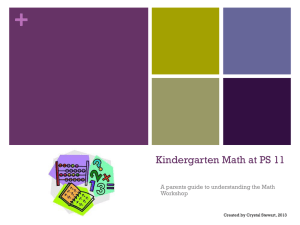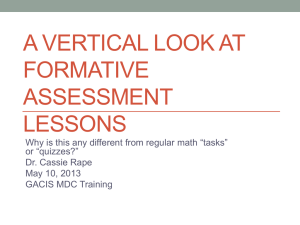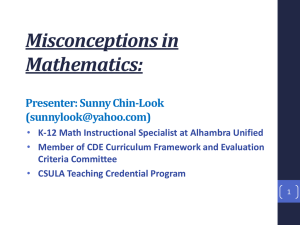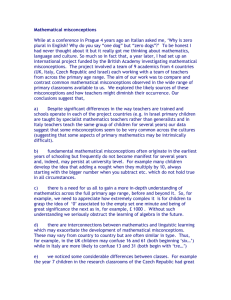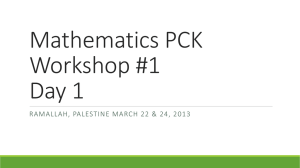Building Number Power Strategies for Math Intervention
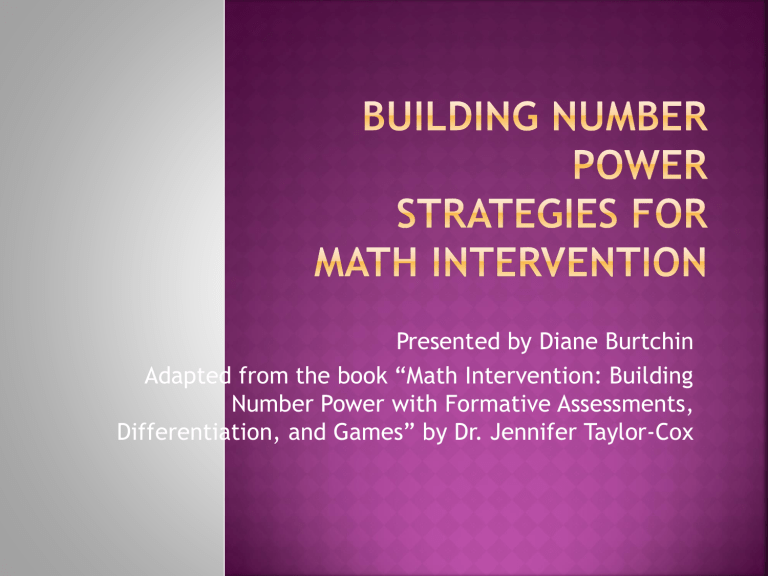
Presented by Diane Burtchin
Adapted from the book “Math Intervention: Building
Number Power with Formative Assessments,
Differentiation, and Games” by Dr. Jennifer Taylor-Cox
To fine tune our definition of math intervention
To discuss the four goals for learning mathematics and to recognize the importance of each
To share important ideas for teaching math and for making math intervention meaningful
To walk away with some games and activities that can be used in your math intervention
Please share with a neighbor your definition of math intervention
Be sure to discuss at least three core elements of successful intervention
What is it?
It is targeted instruction for students struggling with mathematics.
This targeted instruction must focus on the precise academic needs of the students.
Intervention must have a focus on correcting students’ misconceptions and filling in learning gaps in ways that build their mathematical understanding
Accuracy- how to obtain the correct answer
Efficiency- how to obtain the correct answer as quickly as possible
Flexibilty- understanding how to apply their learning to new situations and in different ways (adaptability)
Fluency- relates to the confidence and ease with which students work with mathematics concepts
These goals are interconnected
Timing is very important- we can’t jump to efficiency and flexibility too fast!
Teaching rules and procedures isn’t the same as teaching concepts!
When concepts are ignored and the focus is on rules and procedures, struggling students often develop misconceptions and learning gaps.
If students understand the concepts then we can help them increase their efficiency and flexibility by teaching rules and procedures.
However, we MUST include reasons and connections to make this math meaningful.
Typically the problems that students who struggle in math have relate to number sense and computation.
What is number sense?
It is an expansive and inclusive understanding of numbers and operations that allows a person to make sound judgments and utilize practical and effective math strategies (McIntosh, Reys & Reys
1993).
1.) Instruction needs to be explicit
2.) It is precise
3.) It is focused on students’ immediate learning needs
4.) It applies the structure of RtI
5.) Group structure
6.) Quantity and quality of the tasks
7.) Use of new strategies
8.) Educator’s expertise
9.) Incorporation of problem-solving
10.) Student’s level of motivation
Within math intervention, there should be formative assessment on a regular basis.
It allows us to know what to teach, and it gives us information about what a student already knows.
This will then provide us with the opportunity to adjust our lessons and instruction to match the needs of our students.
The assessments can take a variety of forms: paper-and-pencil, informal questioning, performance tasks, etc.
These assessments can actually save time because we know where to target our instruction rather than “wasting” time teaching everything
Also extremely important for math intervention and the RtI process
Students also need to understand their progress
Questions to ask:
Is the student making progress?
What does the student need to learn next?
How solid is the student’s understanding?
Does the student need more work with a specific concept?
Is the student having difficulty maintaining and utilizing specific concepts?
What misconceptions does the student have?
Where are the learning gaps?
Is the student’s knowledge incomplete? If so, what is missing?
This is often a key component of math intervention
Effective reteaching is not teaching the exact same thing in the exact same way again and again
Reteaching in intervention involves identifying the concept and then presenting it in a different way
This may require the teacher to back up to previous content and skills in order to build prerequisite understanding (filling the gaps)
This may also require the teacher to find and address misconceptions in order to properly learn the new content and skills
It is critical to understand the concepts as well as the progression of student learning
Don’t focus on a particular grade level but rather the level of understanding of the intervention students
Layout of activities:
Formative assessment (for determining level of understanding)
Sample questions (based on Bloom’s Taxonomy)
Math game directly connected to a specific math concept (many of them address multiple concepts)
Content differentiation ideas
Find a chapter that interests you
Suggestions for each grade level:
KG- Ch. 1 Early Number Concepts (one-to-one correspondence, rote counting, rational counting, keeping track, cardinality, conservation of a number, subitizing)
1 st - Ch. 2 Numbers and Number Relationships
Concepts (representing numbers, more and less, equal and unequal, composing and decomposing numbers, understanding 10, ordinal numbers, even and odd, basic place value, basic fractions, estimation)
2 nd and 3rd- Ch. 3 Addition and Subtraction Concepts
(total and parts, counting on and counting back, joining sets, number line proficiency, various addition and subtraction strategies and problems, fact families)
4th- Ch. 2 Multiplication and Division
Concepts (various strategies and problems for multiplication and division, arrays, perfect squares and near squares, fact families)
5 th - Ch. 3 Multifaceted Number Concepts
(expanded form, thousands and millions, properties, prime and composite numbers, multiples, factors, fractions, decimals, and mixed numbers)
Share one take away from today regarding the structure of Math Intervention
Share one activity you would like to try with your students
Share any questions that might still have
Do we need a follow up to this session?
